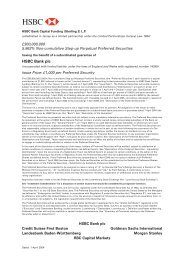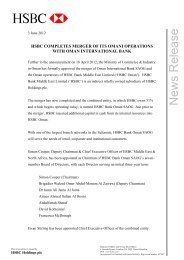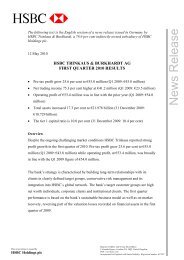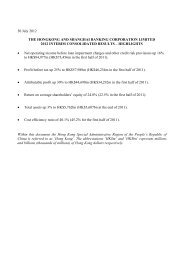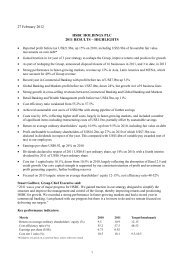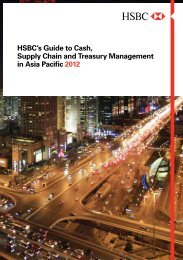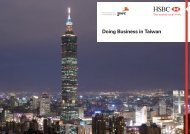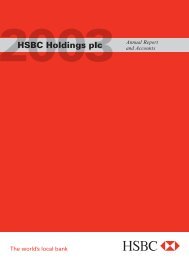Create successful ePaper yourself
Turn your PDF publications into a flip-book with our unique Google optimized e-Paper software.
<strong>HSBC</strong> Archives<br />
<strong>The</strong> <strong>HSBC</strong> <strong>Lions</strong><br />
<strong>Lions</strong> have appeared on the English coatof-arms<br />
ever since the arrival of William<br />
the Conqueror in 1066, and the Peking<br />
Lion holds a great significance in Chinese<br />
tradition. It isn’t surprising therefore, that<br />
two lion sculptures can be found guarding<br />
many of the <strong>HSBC</strong> offices around the<br />
world today.<br />
Stephen and Stitt<br />
Stephen and Stitt<br />
<strong>HSBC</strong>’s association with the sculptured<br />
lions goes back to 1921 when the Chief<br />
Manager, Alexander Stephen, decided a<br />
pair of lions symbolising protection and<br />
security would look impressive outside<br />
the new Shanghai branch which was<br />
being built at the time. In a letter to his<br />
daughters he wrote:<br />
‘‘I wonder what you thought of Venice<br />
and if you noticed the stone lion outside<br />
the Arsenal gate. It made a great<br />
impression on me … a sculptor in London<br />
is sending two lions of his own design.<br />
<strong>The</strong>y look very well and will keep watch in<br />
Shanghai for many centuries to <strong>com</strong>e, I<br />
hope’’.<br />
<strong>The</strong> Shanghai lions were cast in bronze in<br />
England from models prepared by Henry<br />
Poole, and were shipped out to China for<br />
the opening of the new building in 1923. It<br />
was not long before they were nicknamed<br />
‘‘Stephen’’ and ‘‘Stitt’’, after Alexander<br />
Stephen and Gordon Stitt.<br />
Stitt had taken over from Stephen in<br />
Shanghai in 1921 and would remain in<br />
charge there until his retirement in 1926.<br />
Stephen is the growling lion, although the<br />
chief manager was known as a very kind<br />
and even-tempered man!<br />
Hong Kong office<br />
Mr Stephen was not to know that the lions<br />
would be<strong>com</strong>e such important symbols of<br />
growth and prosperity of Hong Kong and<br />
<strong>HSBC</strong>.<br />
<strong>The</strong> Shanghai lions proved so popular that<br />
when a later Chief Manager, Sir Vandeleur<br />
Grayburn, <strong>com</strong>missioned the new Hong<br />
Kong headquarters building in the mid-<br />
1930s, he decided to mount bronze lions on<br />
either side of the grand entrance in Des<br />
Vouex Road. <strong>The</strong> lions were cast in<br />
Shanghai, the work taking just over two<br />
years, and every stage of it was personally<br />
supervised by Mr Wagstaff, who cast the<br />
lions in segments, then joined the parts<br />
together.<br />
<strong>The</strong> castings were finished on time, and<br />
both lions were in place for the opening of<br />
the new headquarters in October 1935.<br />
<strong>The</strong>y have guarded the entrance to the<br />
bank ever since except for two notable<br />
periods of absence.<br />
Stephen guarding the entrance to the 08/2010 Hong<br />
Kong office, 1971<br />
<strong>HSBC</strong> <strong>Lions</strong>
Turbulent Times<br />
<strong>The</strong> first was during the Japanese<br />
occupation of Hong Kong when the lions<br />
were removed and consigned to Japan as<br />
scrap metal. <strong>The</strong> bank was unaware of<br />
their wherabouts until they were spotted<br />
in a Japanese naval dock by a sharp-eyed<br />
American sailor. He had never been to<br />
Hong Kong but had noticed the two lions<br />
outside the Shanghai office of the bank in<br />
a previous posting. He got word to <strong>HSBC</strong><br />
of the fate of the lions, and the bank set<br />
about the task of organising their rescue.<br />
Bringing the lions home to Hong Kong<br />
was not an easy task - they were<br />
eventually shipped back under an order<br />
from General MacArthur, Supreme<br />
Commander of the occupying forces in<br />
Japan. <strong>The</strong>y were restored to their<br />
original position outside the bank in<br />
October 1946 with Stephen the roaring<br />
lion sitting on the left and Stitt the quiet<br />
lion on the right. Both lions had sustained<br />
‘injuries’ from shrapnel damage, which<br />
they still bear today, but their return was<br />
greeted with great interest.<br />
<strong>The</strong> South China Morning Post reported<br />
on 18 October that:<br />
‘‘In the dead of last night the two bronze<br />
lions … crept back to their pedestals and<br />
this morning looked as <strong>com</strong>fortable and<br />
unconcerned as if they had never moved’’.<br />
With the return of the lions to the bank,<br />
prosperity soon began to return to the city<br />
- reinforcing the belief that the lions not<br />
only protect <strong>HSBC</strong> but Hong Kong itself.<br />
<strong>The</strong> Hong Kong lions were removed again<br />
in 1981 and placed in Statue Square for<br />
four years while they waited for a new<br />
and much larger headquarters to be built.<br />
On 1 June 1985, under the watchful eye of<br />
a fung shui expert, the lions were lifted<br />
simultaneously by two cranes to avoid<br />
giving one precedence over the other,<br />
carried to the new building and lowered<br />
into position. A week later the <strong>HSBC</strong><br />
Chairman held an official ceremony to<br />
wel<strong>com</strong>e the lions home.<br />
A Lucky Charm<br />
One of the most endearing features of the<br />
<strong>HSBC</strong> lions is the belief by many that they<br />
hold powers of good fortune.<br />
An article from the August 1936 edition of<br />
Asia Magazine underlines this point:<br />
‘‘Amongst the Chinese population there is<br />
nothing about the Bank’s magnificent<br />
building … that excites greater interest than<br />
the pair of bronze lions flanking the<br />
entrance. <strong>The</strong> paws of these beasts have<br />
been worn smooth in a decade by the<br />
stroking of innumerable optimists who<br />
credit them with the power to confer<br />
wealth’’.<br />
Customer rubbing paw of the lion for good luck,<br />
1929<br />
Today<br />
When <strong>HSBC</strong>’s new global headquarters<br />
were opened in Canary Wharf, London it<br />
was imperative that Stephen and Stitt were<br />
included in the design. <strong>The</strong> lions at 8<br />
Canada Square are exact replicas of their<br />
brothers in Hong Kong, and have eight<br />
lucky coins buried in the base as tradition<br />
dictates -- the number 8 being symbolic of<br />
good fortune in Chinese tradition.<br />
Today the pair’s paws can also be rubbed<br />
for good luck in <strong>HSBC</strong> offices around the<br />
world; from Chicago and Toronto to<br />
Vancouver and Mexico City.<br />
08/2010



